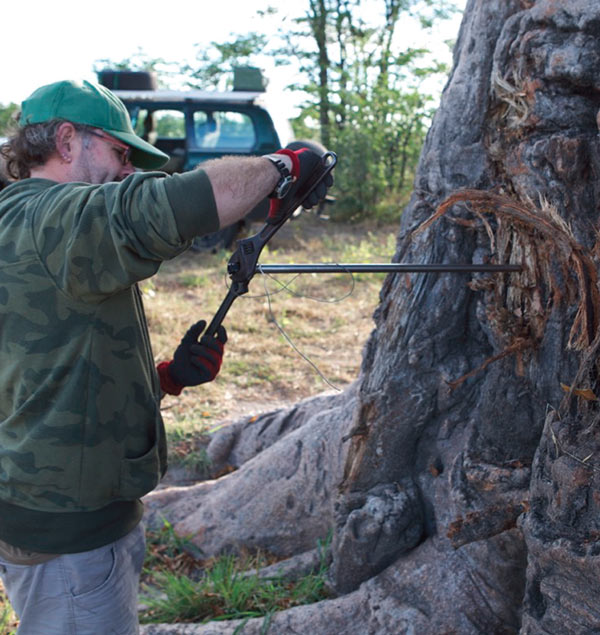A key research programme has been the generation of long-term climate records from selected long-lived indigenous tree species (such as the Baobab Adansonia digitata L.) from across southern Africa. Ancient Baobab trees, which are predominantly found in summer rainfall areas, are excellent study models as they can live for more than 1 000 years and therefore can provide valuable insight into both the natural and anthropogenic effects of climate change over time.
Dr Stephan Woodborne (iThemba Labs, Johannesburg) and Dr Grant Hall (Stable Isotope Laboratory, MRI at UP) are the lead researchers. Based on earlier research carried out on Baobab trees in the Pafuri region of the Kruger National Park and several species in the KwaZulu-Natal region between 2010 and 2013, they realised the potential of providing high-resolution time series analyses of past rainfall based on stable carbon isotope ratios derived from growth rings.
During the lifetime of a tree, carbon is taken up from the atmosphere and incorporated into the wood tissue that forms during the growing season. The stable carbon isotope ratios in each ring vary from year to year and provide a proxy record of each year’s rainfall.
In 2015, Dr Woodborne and Dr Hall carried out two major field trips to collect additional samples of Baobabs from Mapungubwe and Kruger National Parks in South Africa, and from the Epupa Falls in northern Namibia to complement the existing isotope time series. Baobab core samples and trunk discs from Camel-thorns (Acacia erioloba) were also collected along a north-south transect across Botswana. The second field trip was to south-western Madagascar where Dr Hall assisted with the sampling of several Madagascan Baobab species.
Cores up to 1,5 metres in length are taken from living Baobabs using an increment borer. This procedure does not damage the trees and the holes created are sealed as soon as the core is removed. The chemistry of the wood reflects the growing conditions and the periods during which growth occurred (rainfall periods), as well as the periods during which the trees were under water stress (drought periods). As a tree grows, new rings are formed year after year, and the chemistry of each ring gives insight into climate change in that locality.
The processing for stable isotope analysis and high-precision radiocarbon dating started in 2015. By the end of 2016 the project will have produced a 1 000-year record of past rainfall across southern Africa.
A vast amount of data for wide-ranging stable isotope-related projects has been generated. In addition, the facility provides training and analytical services, and collaborates with several institutions in South Africa and internationally. In 2015 Dr Hall and Dr Woodborne worked closely with researchers and students from numerous international institutes as well as locally with SANParks and the universities of Cape Town and KwaZulu-Natal. In addition, datasets have been used by climate modellers from Sweden and the Council for Scientific and Industrial Research (CSIR) to improve the predictive power of global climate models and to mitigate the effects of climate change in southern Africa.
 Dr Grant Hall coring a Baobab
Dr Grant Hall coring a Baobab
 Photo by Grant Hall
Photo by Grant Hall